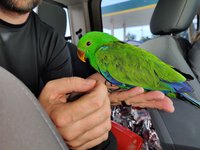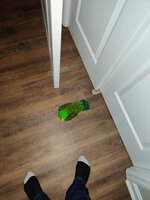MyDjango
Moving in
- Joined
- 1/30/20
- Messages
- 5
Howdy people! I just signed up and thought I should start asking around about this after coming up empty reading other forum posts. I've seen two vets now and had my 9 month old tested and checked to make sure his diet isn't an issue or that he isn't having some underlying problem. Both vets said he needs to molt his baby feathers (which he still hasn't finished doing, although he's been growing new feathers since November but still hasn't lost/grown any primaries). One vet mentioned that it could be a genetic issue (possibly he's inbred), or that it could be from how his feathers developed when he was being fed from the breeder. The first photo is from when I first got him, he had stress bars and his feathers were more yellowish than greenish and they all started to turn blackish when he started preening, which started around last September/October. It's just gotten progressively worse to the point where people who don't even know anything about parrots are asking about his feathers and if that's normal. It isn't. So I am just reaching out to see if anyone else has had any issues with how feathers look before a molt. The only thing I can think of is that it's very dry in our new house (just moved in November), and he does seem quite itchy and his feathers seem dryer/more brittle. He has a humidifier in his room, but I take him around the house with me during the day, so not sure how much that's helping, although I do mist him with water twice a day and he gets a shower every 3 days. It's just very upsetting to see his feathers in this condition when we feel we're trying hard to do everything right and his behavior is so good and he seems so happy aside from him aggressively preening sometimes.
One other thing I found odd (and scary) is that both vets said to feed him more pellets, not the veggies and beans I've been giving him. He gets a variety of fresh foods and also the Birdtricks/tops pellets, but they said I should be giving him more pellets than I am. I'm not even sure he should be getting any pellets based on what I've read about ekkies, but he's a very picky eater and tends to throw out the veggies he doesn't feel like having from one day to the next. Sometimes it's a good day for carrots, other days he won't touch them, and he refuses veggies in chopped form, so he justs gets a variety every day and chooses what he wants from that. I weigh him every morning/night and his weight has been fine and steady. He currently weighs around 240 in the mornings and about 25-260 in the evenings.
One other thing I found odd (and scary) is that both vets said to feed him more pellets, not the veggies and beans I've been giving him. He gets a variety of fresh foods and also the Birdtricks/tops pellets, but they said I should be giving him more pellets than I am. I'm not even sure he should be getting any pellets based on what I've read about ekkies, but he's a very picky eater and tends to throw out the veggies he doesn't feel like having from one day to the next. Sometimes it's a good day for carrots, other days he won't touch them, and he refuses veggies in chopped form, so he justs gets a variety every day and chooses what he wants from that. I weigh him every morning/night and his weight has been fine and steady. He currently weighs around 240 in the mornings and about 25-260 in the evenings.
Attachments
-
108.9 KB Views: 36
-
110.7 KB Views: 38
-
47.1 KB Views: 41







